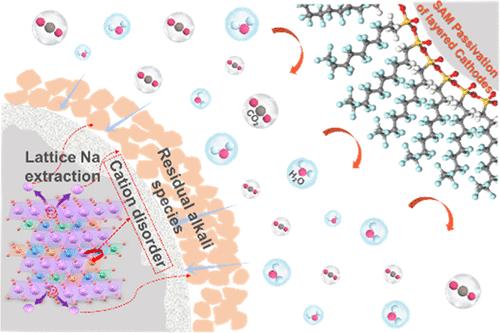Our official English website, www.x-mol.net, welcomes your feedback! (Note: you will need to create a separate account there.)
Air Corrosion of Layered Cathode Materials for Sodium-Ion Batteries: Cation Mixing and a Practical Suppression Strategy
ACS Nano ( IF 17.1 ) Pub Date : 2024-05-09 , DOI: 10.1021/acsnano.4c01962 Yifan Huang 1, 2 , Wujun Zhang 2 , Yangfan Zhou 3 , Yueqi Wang 2 , Linsen Li 4 , Hui Shao 2 , Xinrui Li 2 , Zijian Hong 3, 5 , Hui Xia 1 , Yanbin Shen 2 , Liwei Chen 2, 6
ACS Nano ( IF 17.1 ) Pub Date : 2024-05-09 , DOI: 10.1021/acsnano.4c01962 Yifan Huang 1, 2 , Wujun Zhang 2 , Yangfan Zhou 3 , Yueqi Wang 2 , Linsen Li 4 , Hui Shao 2 , Xinrui Li 2 , Zijian Hong 3, 5 , Hui Xia 1 , Yanbin Shen 2 , Liwei Chen 2, 6
Affiliation

|
Layered oxide cathodes of sodium-ion batteries (SIBs) are considered promising candidates due to their fascinating high capacity, good cyclability, and environmental friendliness. However, the air sensitivity of layered SIB cathodes causes high electrode manufacturing costs and performance deterioration, hampering their practical application. Herein, a commercial O3-type layered Na(Ni1/3Fe1/3Mn1/3)O2 (NNFM) material is adopted to investigate the air corrosive problem and the suppression strategy. We reveal that once the layered material comes in contact with ambient air, cations migrate from transition metal (TM) layers to sodium layers at the near surface, although Na+ and TM ions show quite different ion radii. Experimental results and theoretical calculations show that more Ni/Na disorder occurs in the air-exposed O3-NNFM materials, owing to a lower Ni migration energy barrier. The cation mixing results in detrimental structural distortion, along with the formation of residual alkali species on the surface, leading to high impedance for Na+ diffusion during charge/discharge. To tackle this problem, an ultrathin and uniform hydrophobic molecular layer of perfluorodecyl trimethoxysilane is assembled on the O3-NNFM surface, which significantly suppresses unfavorable chemistry and structure degradation during air storage. The in-depth understanding of the structural degradation mechanism and suppression strategy presented in this work can facilitate high-energy cathode manufacturing from the perspective of future practical implementation and commercialization.
中文翻译:

钠离子电池层状正极材料的空气腐蚀:阳离子混合和实用的抑制策略
钠离子电池(SIB)的层状氧化物阴极因其令人着迷的高容量、良好的循环性和环境友好性而被认为是有前途的候选者。然而,层状SIB正极的空气敏感性导致电极制造成本高和性能恶化,阻碍了其实际应用。本文采用商用O3型层状Na(Ni 1/3 Fe 1/3 Mn 1/3 )O 2 (NNFM)材料来研究空气腐蚀问题和抑制策略。我们发现,一旦层状材料与环境空气接触,阳离子就会从过渡金属(TM)层迁移到近表面的钠层,尽管Na +和TM离子显示出截然不同的离子半径。实验结果和理论计算表明,由于Ni迁移能垒较低,暴露在空气中的O3-NNFM材料中出现了更多的Ni/Na无序。阳离子混合导致有害的结构变形,并在表面形成残留碱物质,导致充电/放电期间Na +扩散的高阻抗。为了解决这个问题,在O3-NNFM表面组装了超薄且均匀的全氟癸基三甲氧基硅烷疏水分子层,这显着抑制了空气储存过程中不利的化学和结构降解。这项工作中提出的对结构退化机制和抑制策略的深入理解可以从未来实际实施和商业化的角度促进高能阴极制造。
更新日期:2024-05-09
中文翻译:

钠离子电池层状正极材料的空气腐蚀:阳离子混合和实用的抑制策略
钠离子电池(SIB)的层状氧化物阴极因其令人着迷的高容量、良好的循环性和环境友好性而被认为是有前途的候选者。然而,层状SIB正极的空气敏感性导致电极制造成本高和性能恶化,阻碍了其实际应用。本文采用商用O3型层状Na(Ni 1/3 Fe 1/3 Mn 1/3 )O 2 (NNFM)材料来研究空气腐蚀问题和抑制策略。我们发现,一旦层状材料与环境空气接触,阳离子就会从过渡金属(TM)层迁移到近表面的钠层,尽管Na +和TM离子显示出截然不同的离子半径。实验结果和理论计算表明,由于Ni迁移能垒较低,暴露在空气中的O3-NNFM材料中出现了更多的Ni/Na无序。阳离子混合导致有害的结构变形,并在表面形成残留碱物质,导致充电/放电期间Na +扩散的高阻抗。为了解决这个问题,在O3-NNFM表面组装了超薄且均匀的全氟癸基三甲氧基硅烷疏水分子层,这显着抑制了空气储存过程中不利的化学和结构降解。这项工作中提出的对结构退化机制和抑制策略的深入理解可以从未来实际实施和商业化的角度促进高能阴极制造。






























 京公网安备 11010802027423号
京公网安备 11010802027423号